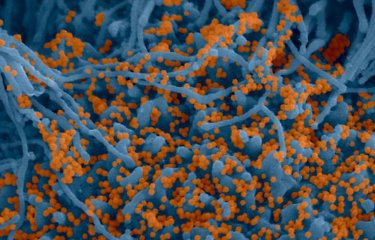-
News | 2016.04.04
Division – a key moment in establishing cell polarity
One major line of research on the process of carcinogenesis lies in understanding the mechanisms underpinning the establishment of polarity. The Membrane Traffic and Cell Division Laboratory, directed at the Institut Pasteur by Arnaud Echard (Institut Pasteur/CNRS UMR 3691), is looking into apical-basal polarity acquisition mechanisms during cell division when organs are being formed. The team...
-
News | 2016.03.25
How Chlamydia trachomatis hijacks energy stores from its host
A publication in eLife from researchers of the Institut Pasteur, CNRS, University of Lille and Indiana University (USA) explains the mechanisms by which the bacterium Chlamydia trachomatis hijacks nutrients of its host to its own benefit.Chlamydia trachomatis is the most common bacterial cause of sexually transmitted infection. These infections are often asymptomatic and are a major cause for...
-
News | 2016.03.10
Unmasking an ancestral mechanism of integrons — key players in antibiotic resistance
With the ultimate aim of combating antibiotic resistance acquired by bacteria during evolution, researchers from the Institut Pasteur and CNRS have managed to shed light on one of the mechanisms of DNA recombination in bacteria.Resistance genes are transferred between pathogenic bacteria via different pathways, but always as a single strand of DNA. One of the main players in these transfers is...
-
News | 2016.03.04
Low competence of Aedes mosquitoes for Zika virus transmission
The Institut Pasteur's Arboviruses and Insect Vectors Unit, led by Anna-Bella Failloux, working in cooperation with the Institut Pasteur International Network (the Institut Pasteur in Guadeloupe, the Institut Pasteur in French Guiana, the Instituto Oswaldo Cruz-Fiocruz and the Institut Pasteur in New Caledonia) and the Centre for Mosquito Control in Martinique, has carried out a study on the...
-
News | 2016.02.01
How does Legionella pneumophila, the bacterium causing legionellosis, use the host cell machinery to its own advantage?
During analysis of Legionella pneumophila genome sequence, the team from the Biology of Intracellular Bacteria Unit (Institut Pasteur/CNRS), headed by Carmen Buchrieser, identified genes coding for proteins that were predicted to be involved in the infection of human cells. In this study, published in the journal PNAS, the researchers show that one of these proteins is secreted in the human cell...
-
Report | 2016.12.30
Understanding autism
Arthur has been rocking backwards and forwards for several minutes. At his feet is a drawing, identical to the one he drew a few hours earlier, and to others he will create again and again. His mother calls him. He takes no notice, as though he hadn’t heard. At 5 years old, Arthur is in his own world. Like more than 100,000 other children in France – and, according to some estimations, 650,000...
-
News | 2016.08.10
Disturbing prevalence of antibiotic-resistant Enterobacteriaceae in Central African children
Nearly 59% of Central African children under 5 years, are asymptomatic carriers of extended-spectrum β-lactamase-producing Enterobacteriaceae (ESBL-E); one of the highest prevalence ever described in the world. These bacteria are resistant to every antibiotics currently marketed in Central African Republic.Alain Farra, Thierry Frank and Sébastien Breurec (1), from Bacteriology Laboratory at the...
-
News | 2016.10.20
Table salt to diagnose malaria
At the Centre Pasteur in Cameroon, the International Four Year Group (G4) on malaria created in 2013 is developping a diagnostic test working with common table salt. Dr. Lawrence Ayong, head of the group explains how this innovative tool works as well as his ambitious research program on malaria.Dr Lawrence Ayong, Responsable du laboratoire de recherche sur le paludisme au Centre Pasteur du...
-
News | 2016.09.22
Culex mosquitoes do not transmit Zika virus
Since the first cases of infection were identified in Brazil, in May 2015, the Zika virus has spread to over 46 countries in America. Several hypothesis are discussed to explain the extent of the epidemic and the rapidity with which the virus has invaded the continent. The transmission could be facilitated by the absence of immunity of the American populations as the virus comes from Africa but...
-
News | 2016.12.15
MediLabSecure contributes to Zika preparedness in the Mediterranean area
The current Zika virus emergence has highlighted the global need to conduct comprehensive risk assessments and develop preparedness activities against arboviral threats. An article published in BMC Public Health examines how the actions and strategies implemented by the MediLabSecure network contribute to the prevention and control of the Zika virus threat in the Euro-Mediterranean area.Thanks to...


